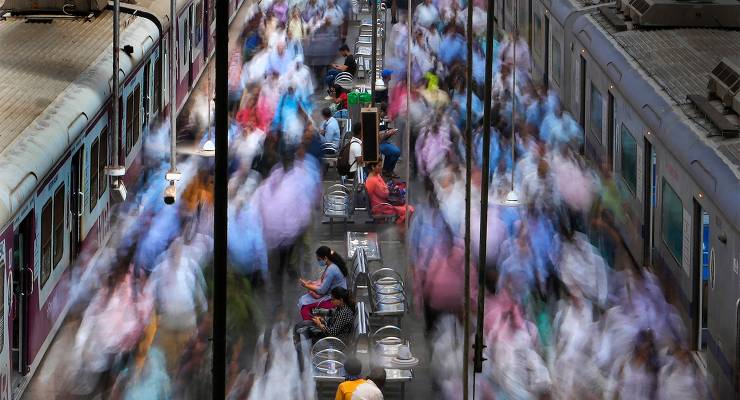
India has become the world’s most populous country, with its estimated 1.4286 billion people overtaking mainland China’s 1.4257 billion as of the end of April, according to the latest United Nations estimates.
This changing of the guard has come quicker than previously expected, with earlier reports estimating that India wouldn’t surpass China until later this decade. But the timing has been accelerated by China’s fertility rate continuing to wallow, with a 2022 estimate of only 1.18 births per woman compared to a replacement rate of 2.1 births, which would keep the population steady.
These precise population numbers are educated “guesstimates” by statisticians, assumptions made on the back of China’s 2020 census and India’s older 2011 census — combined with data on births and deaths. But nonetheless, this is the first time since the 1950s that China hasn’t been the world’s most populous nation.
One-child policy and Chinese demographics
The trend has been clear for some decades now, especially in light of China’s controversial one-child policy and the horrors that came with it, including an estimated 336 million abortions, often forced, and hefty fines that ranged from a few hundred dollars to as much as US$1.2m (A$1.8m) for internationally lauded film director Zhang Yimou’s third child. Official statistics showed that 196 million men and women were sterilised between 1971 and 2003.
Chinese families are still having fewer children, despite the relaxation of the one-child policy since 2016. By 2021, all limits were removed. But due to the spiralling cost of living in China, and an entire generation has been socialised into having one child, there has been little appetite to change the status quo. Indeed, the number of annual marriage registrations in China continues to fall — hitting a 35-year low in 2021 — and divorce rates are rising as millions are opting to stay single.
The gap between the world’s two population behemoths is set to dramatically widen too. The UN has estimated China’s population could drop below 1 billion before the end of the century, while India’s is expected to continue growing for several decades, reaching 1.5 billion by 2030 and potentially hitting 2 billion by 2100.
The population swing will be a psychological blow for China. In some ways, it is one of the rungs of the CCP’s justification for its “peaceful rise”, including its determination to retake its place as the preeminent power in Asia.
But in terms of resources, a reduced population could be a good thing. China is not self-sufficient in food or energy, and its water resources in particular have been strained.
China’s emerging demographics are also a major burden on its economy, with fewer people each year of working and tax-paying age to look after its ageing population. It is succumbing to the problem of its population “getting old before it gets rich”.
The effects of China’s demographics will be different in the wealthier parts of China, where people have been able to accumulate significant personal wealth along its east coast, compared to much of the still-impoverished inland. This often stark inequality is something its leader Xi Jinping has been very vocal about in recent years.
India’s boom in people and wealth
Like China, India is a net importer of energy and resources, with demand rising as its urbanisation and industrialisation continue. Estimates for 2050 are 675 million people living in urban areas in India and 1 billion in China.
As India’s population booms, its far younger average age — just 28 compared with China’s 39 — bodes better for its rise as a low-cost manufacturing nation, the same demographic benefit that underpinned China’s growth these past 40 years. Indeed the pace of India’s growth is now outstripping China’s, with GDP growth of 7% in the first quarter of 2023 compared to 4.4% in China.
Yet despite effectively equal populations, the two country’s economic strengths remain vastly different, making India’s own rise difficult. India’s 2022 GDP of US$3.2 trillion pales against China’s US$18.1 trillion. It also still struggles with far more poverty than China, a problem exacerbated by the COVID pandemic, which saw a further 75 million Indian fall into poverty versus only 1 million in China.
In trying to emulate China’s 40 years of economic success, India faces many of the same problems. It is not self-sufficient in food, minerals or energy, and its transport infrastructure remains substandard, crimping better growth. Yet the most critical is water: with about 18% of the world’s population, India has only 4% of its water resources. Like China, it relies heavily on the Himalayas — often known as the world’s third pole — for run-off for its rivers and agriculture. Climate change is also driving the increasingly erratic monsoon season upon which India relies for water and food security.
Like China, India is trapped between the desire to grow its economy, improve the well-being of its citizens, and help the global effort to ameliorate the effects of climate change. For now, that seems like a very big stretch — and therein lies a problem for the rest of the world.








The one truely global news item of the month. This has implications for all countries and the planet. How India manages its population and their impact will remain crucial for at least the next 100 years, if not longer. I wish India well, we all need it to succeed.
China owns the headwaters of all the rivers S. and E. Asia depend on. Invading Tibet was the smartest thing Mao did, in hindsight, but the changing climate will have the last roll of the dice. I see India as far more complicated than China, with more problems to overcome. Language, government, climate, religion, as well as the caste system. Overcoming poverty and ignorance, even if seen as a good thing, has no formula. Are we there yet?
India is doing a hell of a lot more than “help the global effort to ameliorate the effects of climate change”. India has developed 6.8 GW of nuclear electricity and is currently constructing a further 6 GW. In contrast, Australia has increased its production of gas – methane. Stopping climate change is the order of the day, and replacing all fossil fuels is prerequisite.
Bit simplistic e.g. ‘But in terms of resources, a reduced population could be a good thing. China is not self-sufficient in food or energy, and its water resources in particular have been strained.’
This is a symptom of suboptimal headline data ‘analysis’ but ignoring various local factors, drivers and dynamics known for generations with UNPD (inexplicably) inflating future forecasts vs. declining fertility (highlighted by regular UNPD downgrades & independent researchers using local demographers calling out e.g. Bricker & Ibbitson); it’s simply about ‘managing’ the population vs. (headline) population ‘control’.
Indian demographer Sanjeev Sanyal in 2011 wrote for Project Syndicate:
‘The End of Population Growth. The UN forecasts that world population will rise to 9.3 billion in 2050 and surpass 10 billion by the end of this century. But such forecasts misrepresent underlying demographic dynamics: The future we face is not one of too much population growth, but too little.‘
Contestable, but predicted decline in fertility, India will follow China; in hindsight China should have had a two child policy?